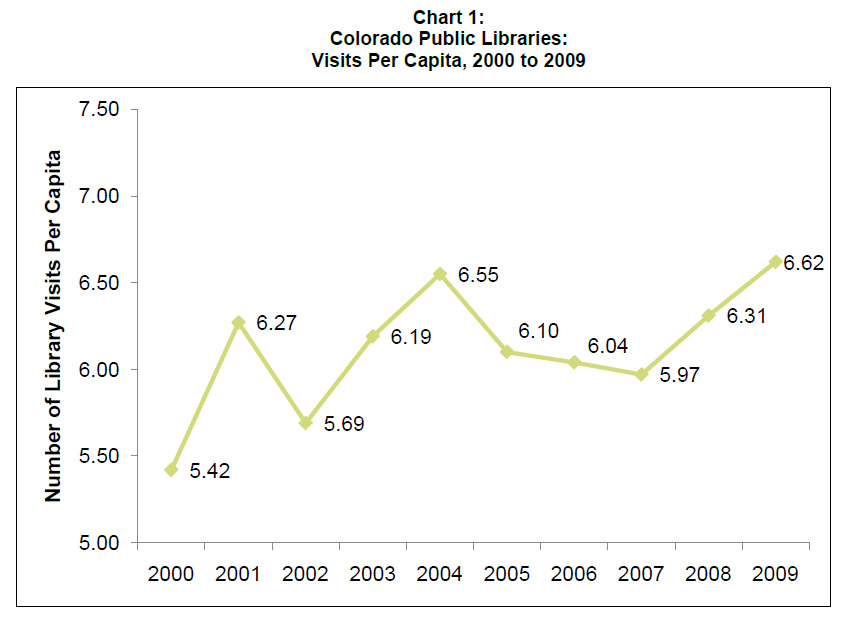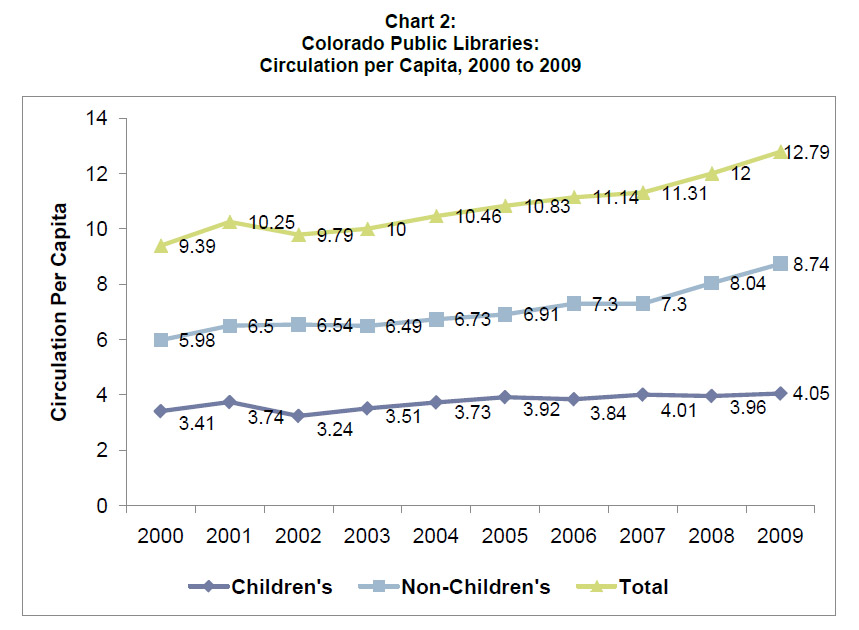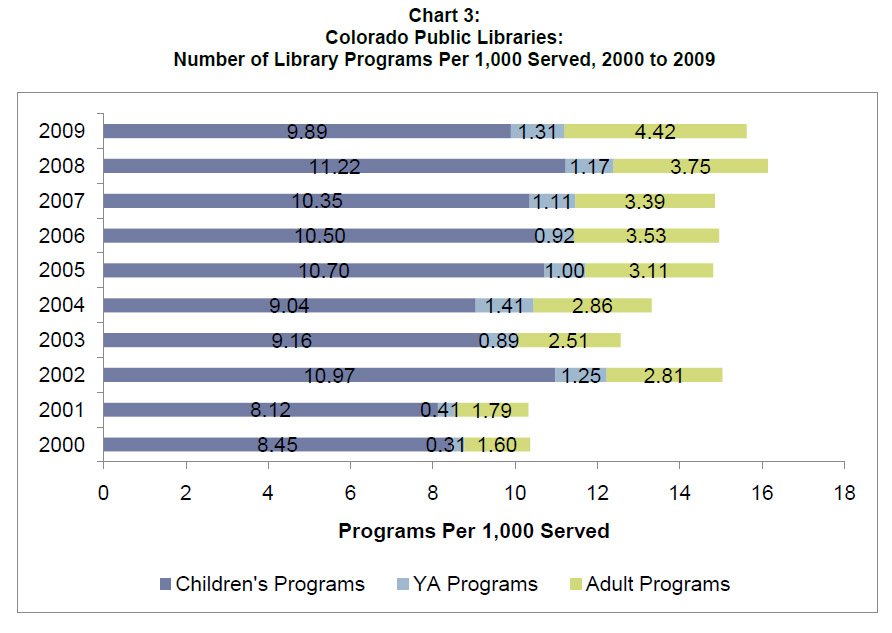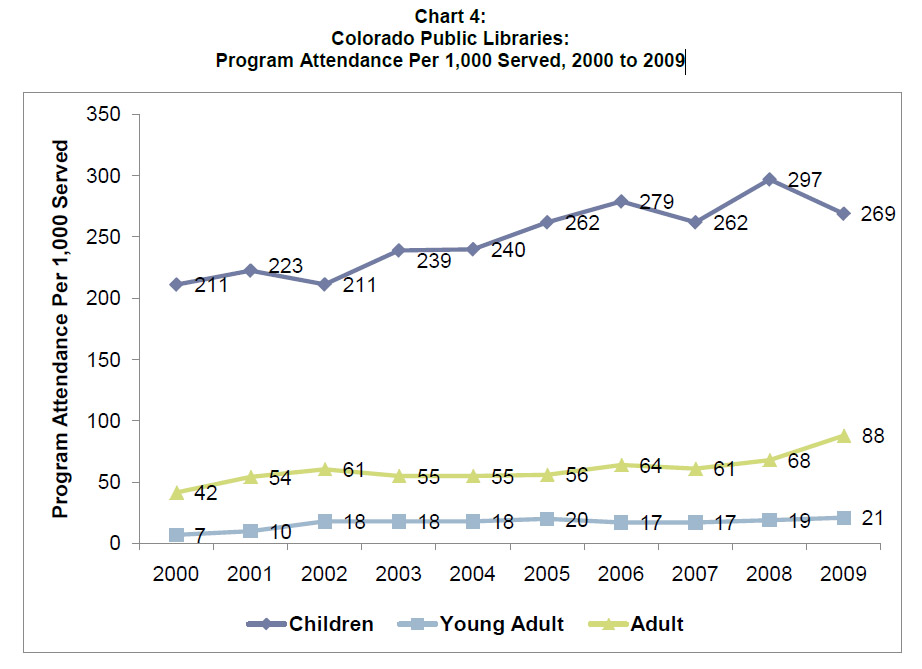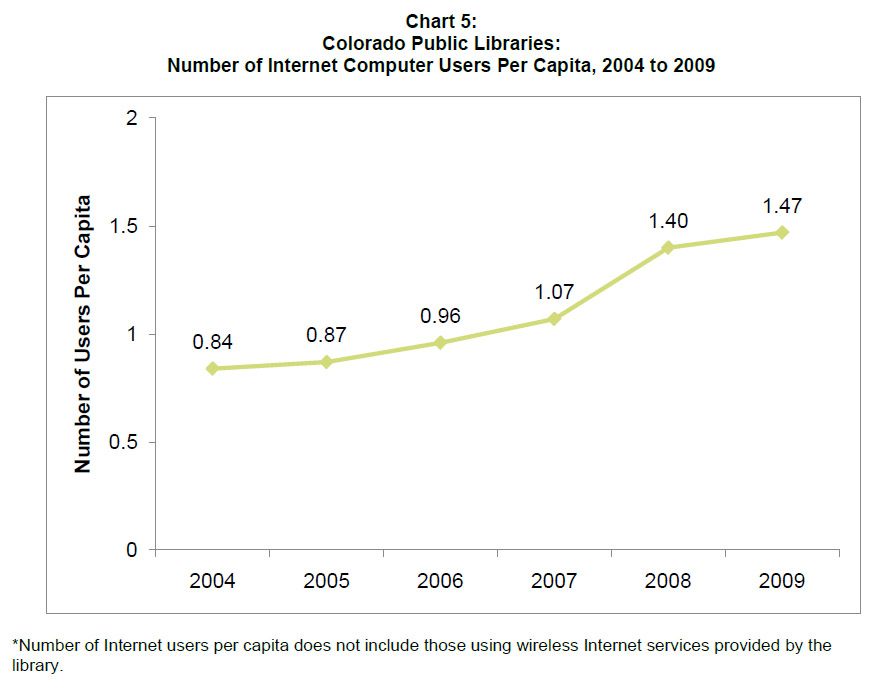Colorado’s public libraries had another busy year in 2009. Library visits, circulation, and users of Internet computers reached record highs, and program attendance has risen considerably over the past decade. These four statistics are used to compute the Library Journal (LJ) Index of Public Library Service, a system that ranks the output measures of libraries nationwide so that their accomplishments may be recognized. Libraries with the top rankings within their expenditure group are honored as “Star Libraries.”[note]Libraries that have the top 30 scores within their expenditure group (top 15 for those in the $30 million and above group) receive stars. http://www.libraryjournal.com/article/CA6705616.html#FAQ8.[/note] This Fast Facts will assess how Colorado is doing on the data elements used in the LJ Index.
Library Visits
Colorado public library visits have risen from 22.6 million in 2000 to over 32.8 million in 2009. The sheer number of total visitors makes for busy libraries; the 6.62 visits per capita measure in 2009 tops the previous record of 6.55 visits per capita in 2004 (Chart 1). Overall, library visits per capita have increased by 22 percent over the past decade.
Circulation
Total materials circulation has increased steadily since 2000, peaking in 2009 with over 63.3 million materials circulated. Per capita circulation has grown by 36 percent from 2000 to 2009 (Chart 2). Children’s materials circulation per capita, which traditionally makes up around one-third of total circulation, has seen a 19 percent increase. Non-children’s materials circulation has been more integral to the overall increase, rising by 46 percent over the decade.
Programs
Not only are Coloradans visiting the library and checking out materials, they have also been attending the multitude of programs offered by their libraries. In 2008, the total number of programs offered reached 78,682, or 16.14 programs per 1,000 served, a record high for Colorado’s public libraries.
The number of programs in 2009 was slightly lower (77,399, or 15.62 programs per 1,000 served). This decrease from the previous year can be attributed to a 12 percent drop in children’s programs, from 11.22 (2008) to 9.89 (2009) programs per 1,000 served (Chart 3).
In contrast, the number of adult programs per 1,000 served increased by 18 percent in 2009, and young adult (YA) programs went up by 12 percent. The 2009 statistics reflect a change in the definition of YA programs to include attendees between 12 and 17 years of age; in prior years YA programs included attendees between 14 and 17 years of age. Therefore, increases in the numbers of YA programs and program attendees reported and decreases in the number of children’s programs and attendees reported are likely due, at least in part, to this definition change.
From 2000 to 2009, there was considerable growth in the number of YA and adult programs per 1,000 served. The numbers of both of these types of programs approximately tripled during this time period. Children’s programs per 1,000 served increased by 17 percent from 2000 to 2009.
The greater increase in the number of adult and YA programs over the past decade, as compared with children’s programs, has shifted the overall proportions of programs offered in Colorado libraries. In 2000, children’s programs accounted for 82 percent of the total number of programs. In 2009, the proportion of children’s programs decreased to account for 63 percent of the total number of programs. Children’s programs are still a driving force in library programming totals, but YA and adult programs are becoming increasingly common.
Total attendance at Colorado library programs reached 1.87 million in 2009, an increase of more than 793,000 attendees since 2000. With the exception of dips in 2002, 2007, and 2009, total program attendance per 1,000 served has otherwise been on the rise over the past decade. YA program attendance per 1,000 served has tripled, adult attendance has more than doubled, and children’s attendance has increased by 27 percent (Chart 4).
Internet Users
During the past decade, libraries have steadily increased their capacity to deliver online content through public access Internet computers, and since 2004[note]Figures prior to 2004 are not discussed because there is anomalous data.[/note] the number of users of Internet computers has risen for five consecutive years. In 2009 there were 75 percent more Internet users per capita at Colorado libraries than there were in 2004 (Chart 5). Over half of that growth (58%) took place between 2007 and 2009. The recent surge in Internet users may also be due to the economic recession that began in December 2007. During periods of economic decline, people often cut back on discretionary spending such as home Internet access, and libraries may serve as an alternate point of access for them.
Does Colorado Deserve a Star?
The LJ Index of Public Library Service for 2010 has announced that Colorado is currently home to eight Star Libraries (using 2008 data). Over the past decade there have been upward trends in each of the output measures used to calculate these ratings. During a time when there has been vocal opposition of government services and libraries by proponents of budget and tax cuts, it is important to note that demand for library services is high, and Colorado’s public libraries have been successful in delivering these valued services.
